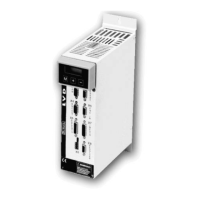Parker Hannifin S.p.A. - Divisione S.B.C. LVD User’s Manual
36
3.5 Speed control loop calibration
IMPORTANT CONCEPTS
SPEED LOOP: the main task of any drive is to control motor speed so that it follows, as
faithfully as possible, the required speed, which is generally referred to as the REFERENCE.
High fidelity reproduction of the reference implies that motor speed is identical to reference
speed in static conditions and also that it follows speed requirements closely also in the case of
sudden changes in the speed reference (dynamic conditions). To perform this task the drive
must be informed of various characteristics of the motor and the mechanical system to which
the motor is coupled; this type of information is set in the `CALIBRATION PARAMETERS'.
ERROR: the error refers to the difference between reference speed and motor speed. The
error value is utilised by the speed control loop to calculate (using calibration parameters) how
much current to supply to the motor.
TORQUE: current flowing through the motor windings is converted into torque which
allows the motor to accelerate and decelerate.
GAIN: in consideration of the typical applications of the LVD drive, the expression "gain" in
this section of the manual refers to the "stiffness" of the motor shaft. To understand the concept
of stiffness imagine a motor controlled by a drive with speed demand of zero rpm. The motor
shaft will appear immobile but if we apply torque to the shaft it will rotate through an angle that
depends on the amount of torque applied. We can then apply the rated torque of the motor and
then measure the "stiffness angle" in degrees. The resulting value provides an indication of the
fidelity of the drive thus parameterised, although it is clearly not the only fidelity indicator.
WHAT'S NEEDED
To calibrate an LVD drive correctly we recommend using an oscilloscope with memory.
Obviously, the technician in charge must be well versed in the use of the instrument. If it is
impossible to use an oscilloscope, we illustrate, at the end of this section of the manual, an
alternative although less accurate method.

